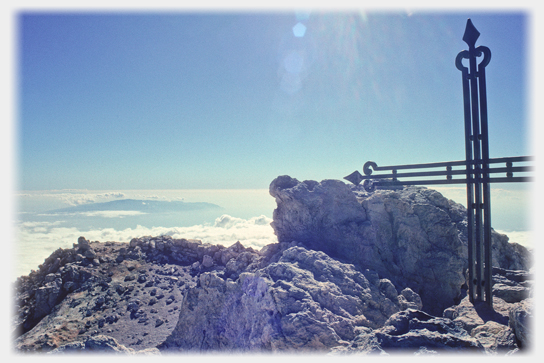
|
The Meaning of World
Standing on Mount Teide, 12,000 feet above the Atlantic Ocean, feels on top of the world. Part of what makes it so spectacular is the howl of the wind in that exposed place, and also the effort of walking up 6,000 feet from the car park - the last two thousand being hard on sea level dwellers. Here indeed we have the sense of the world being spread out below us, this is our planet, the sphere on which we live. There are two other meanings of 'world' also at work. The word can indicate a set of experiences, such as visiting and climbing this mountain, which combined with the rest of life, produce a world view. Thirdly there is the photograph, made to be consumed for my personal pleasure, or added to a collection, or sent to a magazine, or displayed in a gallery, which is part of the photographic world.
These uses of 'world' have made it valuable to modern philosophical discussions, and its very breadth is key to these, but we might have guessed that this abstract sense came to us from concrete panoramas, like the one shown above: many individual personal views could add up to the larger orb. Interestingly it is not so. In the eight hundreds, when the word was first recorded, it was formed from the words for man, and for age; its meaning was the age of man: the span of human existence. A rather abstract meaning very like its modern use in philosophy - our combined public experiences. That early meaning became divided, on the one hand keeping its original sense of present human existence of lives and experiences (or some section of them such as the photographic world), and on the other, to mean the physical universe, or the earth, or a part of the earth.
The earlier meaning can be seen to be evolving, and by Shakespeare's time the word is common, he uses it some 650 times in a way much as we do today, playing in and out of the meanings of geographic location as well as human affairs. This widening of its scope lets it be roughly the totality of "...heaven and earth..." which includes more than Horatio can dream of. This widening has reached its apogee in contemporary philosophy. Wittgenstein writes, in his famous opening of the Tractatus: "The world is everything that is the case."
That is an insistence that nothing is to be left out, and that there is only one world, is crucial to many writers, for example, a few years later Oakeshott, in a rather different philosophical tradition, also insists, at the beginning of his major work, that in philosophy we must proceed "...without presupposition, reservation, arrest or modification." There must be no limits on the world we embrace, understand, explore. From the beginning to the end - everything is included.
Today there is a melding of the uses of the term, it is being valued for its all encompassing sense, the way it brings together my experiences, our experiences, and the planet we live on. But hardly had the ink dried when that unity of one world dissipates into worlds. In Wittgenstein's work the world, which at the start was 'all', turns out not to touch on questions of the meaning of life (6.52), let alone the mystical (6.522). Intriguingly, however much we insist that our world is complete - asking not only that everything is allowed in, but insisting that everything must be included - somehow that insistence is subverted: as soon as it is claimed that there is one world, another world pops up. There can be no single view3 that includes everything. So (thankfully) there is always more of which to dream.
References
- Wittgenstein, Ludwig (1922) 'Tractatus Logico-Philosophicus' Routledge, London. (1.1)
- Oakeshott, Michael (1933) 'Experience and its Modes' Cambridge (p. 2)
- Nagel, Thomas (1986) 'The View from Nowhere' OUP.
14th May 2015 ~ 22nd July 2015